In W.P.(C) 1122/2021-DEL HC- While exercising powers u/s 17 of SARFAESI Act, DRT can look into compliance of provisions of Act and also get into violations of mandatory guidelines of RBI: Delhi HC
Justices Satish Chandra & Subramonium Prasad [14-10-2022]

Read Order: M/S M. SONS GEMS N JJEWELLERY PRIVATE LIMITED & ORS v. RESERVE BANK OF INDIA & ORS
Mansimran Kaur
New Delhi, October 17, 2022: The Delhi High Court has reiterated that the remedy u/s 17(1) of the SARFAESI Act allows the borrower to challenge the actions of the secured creditor on all such grounds which would render the action of the secured creditor illegal.
The Division Bench of Justice Satish Chandra and Justice Subramonium Prasad disposed of the instant petition instituted by the petitioner in the present case by observing that it is always open for the RBI to consider and decide the representation and pass appropriate orders in accordance with law even when the petitioners had already approached the DRT.
Facts relevant for adjudication of the present appeal were that the State Bank of Bikaner and Jaipur (SBBJ) granted cash credit (hypothecation) to the petitioners with a limit to the sum of Rs. 10 crores and a sub-limit of Rs.4 crores. The petitioners were also granted a Bank Guarantee loan of Rs.5crores. In order to secure the cash credit (hypothecation) and the Bank Guarantee granted by SBBJ, the petitioners gave an equity mortgage of two properties.
It was further stated that Laxmi Vilas Bank i.e., the fifth respondent gave cash credit (hypothecation) to the petitioners with a limit for the sum of Rs.5 crores and sub-limit of Rs.2 crores. The Bank Guarantee for the sum of Rs.10 crore was also given to the petitioners and the two properties i.e. Bharat Nagar and Lajpat Nagar property were made by the Petitioners by way of pari passu to secure the said amount.
The cash credit (hypothecation) was enhanced by SBBJ to Rs.10 crores with sub-limit of Rs.4 crores and Bank Guarantee was enhanced to Rs.10 crore.
However, on account of a survey conducted by the Income Tax Department, the bank accounts of the petitioners were frozen. The loan accounts of the petitioners were also frozen by the Income Tax Department. The Bank Guarantees issued by LVB were removed by MMTC Ltd. and the accounts of the petitioners were categorised as Non-Performing Assets (NPA) by SBBJ.
Notices under Section 13(2) of the Securitisation and Reconstruction of Financial Assets and Enforcement of Security Interest Act, 2002 were issued by SBBJ and the LVB demanding outstanding amount of Rs.19.90 crores and Rs.14.94 crores respectively. It was stated that LVB also declared the accounts of the petitioners as NPA. The petitioners subsequently approached the RARC for an OTS Scheme on June 30, 2016 and another OTS Scheme was proposed to RARC by the petitioners on July 30, 2020.
The OTS proposal of the Petitioners was rejected by RARC and the RARC issued a notice under Section 13(2) of the SARFAESI Act demanding a sum of Rs.39 crores.
Thereafter, the petitioners sent a letter to the RBI i.e., the first respondent for cancellation of certificate of registration of RARC under Section 4 of the SARFAESI Act alleging that the provisions of the SARFAESI Act read with Securitisation Companies and Reconstruction Companies (Reserve Bank) Guidelines and Directions, 2003 were violated. Stating that no action was taken by the Reserve Bank of India, the petitioners approached this Court by filing the instant writ petition.
After hearing the submissions from both the sides, the Court noted that, the principal contention of the petitioners was that absence of any judicial remedy by a borrower in case of a flagrant violation of the guidelines/provisions under Chapter II of the SARFAESI Act by an Asset Reconstruction Company renders the entire Chapter ultra vires the Constitution of India. In view of the same, the Court noted that any action by an instrumentality of State is subject to judicial scrutiny under Article 226 of the Constitution of India. It is always open for any borrower to approach the High Court under Article 226 of the Constitution of India contending that the Reserve Bank of India is not exercising due and adequate control over any Asset Reconstruction Company and that the provisions of Chapter II of the SARFAESI Act is being violated.
Further the Court took into consideration the provision of SARFAESI Act. In pursuance of the same, the Court noted that under the SARFAESI Act, powers have been given to the Reserve Bank of India to determine policy and issue directions to the Asset Reconstruction Companies to regulate their affairs. In fact, if the Asset Reconstruction Companies do not follow the guidelines, the Reserve Bank of India has been given power to revoke the certificate of registration granted to them under Section 4 of the SARFAESI Act.
The Court took into account Section 17 of the SARFAESI Act, which pertains to right to appeal. In furtherance of the same, the Court noted that it is well settled that the remedy u/s 17(1) of the SARFAESI Act allows the borrower to challenge the actions of the secured creditor on all such grounds which would render the action of the secured creditor illegal. The DRT while exercising its powers under Section 17 of the SARFAESI Act is not restricted to the compliance of provisions of the Act alone and can get into violations of other provisions such as mandatory guidelines of RBI and other incidental questions.
In addition to the same, the Court noted the DRT under Section 17(3) of the SARFAESI Act has the power to examine whether the actions of the secured creditor are in accordance with the provisions of the SARFAESI Act and the rules made thereunder. The remedy under Section 17 of the SARFAESI Act is not restricted to Chapter III of the SARFAESI Act and the DRT has power to look into the compliance of the secured creditor with other provisions of law, and not just provisions of the SARFAESI Act and rules framed thereunder.
The petitioners failed to establish how the legislature has acted in a capricious or irrational manner or how any of these provisions are excessive or disproportionate. The provisions of the SARFAESI Act as a whole have been made to give effect to its purpose and object and the legislature has enacted the legislation on rational and determined principles, the Court observed.
In light of the foregoing, it was held that Chapter II of the SARFAESI Act is not manifestly arbitrary and is not in violation of Article 14 of the Constitution of India. Accordingly, the prayer of the Petitioners seeking a writ to strike down Chapter II of the SARFAESI Act was rejected.
It was further brought to the notice of this Court that petitioners had already approached the DRT by raising objections regarding the modus adopted by the third respondent- RARC for sale of the property.
In pursuance of the same, the Court stated that it is not going into those issues at this juncture. It was left to the petitioners and the third respondent to raise all the contentions available to them before the DRT. It was also stated by counsel for the petitioners that representations were pending before the RBI, in that respect the Court stated that it is always open for the RBI to consider and decide the representation and pass appropriate orders in accordance with law even when the petitioners had already approached the DRT, the Court opined. The petition was disposed of with such observations.
Sign up for our weekly newsletter to stay up to date on our product, events featured blog, special offer and all of the exciting things that take place here at Legitquest.




Add a Comment